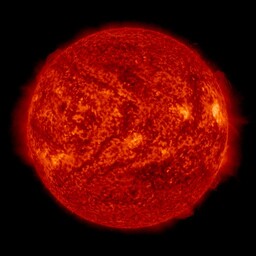
M57 (Ring Nebula), an iconic planetary nebula in the northern celestial hemisphere [Source]
A planetary nebula is the quiet death of a low mass star. It is what our own Sun will eventually become. Not all stars are massive enough to fuse into heavier elements—including eventually iron—to end their lives as a massive supernova. Instead their cores become degenerate (a collection of non-interacting particles) before reaching the required ignition temperature for additional nuclear fusion into heavier elements. The fuel-exhausted star’s outer gas layers are then ejected into space— where they can become ionized as a planetary nebula—and all that remains is the degenerate core: a white dwarf star.
The radiation emitted by the ionized gas of a planetary nebula features a distinctive spectrum, characterized by two especially bright emission lines at 500.7 nm and 495.9 nm, both in the green part of the visual spectrum. First noticed in 1864, these were initially thought to be indicative of a new element—later referred to as “nebulium”—as the spectral lines did not match any known elements at the time. However, this was found not to be the case six decades later, when they were instead revealed to be the forbidden lines of doubly ionized oxygen (O-III), which can only materialize in conditions of extremely low density (incapable of simulation in laboratories on Earth).

The spectrum of M57, exemplifying the emission lines characteristic of a planetary nebula [Source]
Planetary nebulae are some of the most diverse astronomical objects. For this reason, many observers find planetary nebulae to be their favorite kind of deep sky object.
Posts on planetary nebulae:
- M27 (Dumbbell Nebula), in Vulpecula
- M57 (Ring Nebula), in Lyra
- M76 (Little Dumbbell Nebula), in Perseus
- M97 (Owl Nebula), in Ursa Major
- NGC 40 (Bow-Tie Nebula), in Cepheus
- NGC 246 (Skull Nebula), in Cetus
- NGC 1360, in Fornax
- NGC 1501 (Oyster Nebula), in Camelopardalis
- NGC 1514 (Crystal Ball Nebula), in Taurus
- NGC 1535 (Cleopatra’s Eye), in Eridanus
- NGC 2022, in Orion
- NGC 2346, in Monoceros
- NGC 2371-2 (Gemini Nebula)
- NGC 2392 (Eskimo Nebula), in Gemini
- NGC 2438, in Puppis
- NGC 2452, in Puppis
- NGC 2610, in Hydra
- NGC 2818, in Pyxis
- NGC 2867, in Carina
- NGC 3132 (Eight Burst Nebula), in Vela
- NGC 3242 (Ghost of Jupiter), in Hydra
- NGC 4361, in Corvus
- NGC 6026, in Lupus
- NGC 6058, in Hercules
- NGC 6072, in Scorpius
- NGC 6210 (Turtle Nebula), in Hercules
- NGC 6302 (Bug Nebula), in Scorpius
- NGC 6309 (Box Nebula), in Ophiuchus
- NGC 6337 (Cheerio Nebula), in Scorpius
- NGC 6543 (Cat’s Eye Nebula), in Draco
- NGC 6563, in Sagittarius
- NGC 6572 (Blue Racquetball), in Ophiuchus
- NGC 6742, in Draco
- NGC 6751, in Aquila
- NGC 6765, in Lyra
- NGC 6772, in Aquila
- NGC 6778, in Aquila
- NGC 6781, in Aquila
- NGC 6818 (Little Gem Nebula), in Sagittarius
- NGC 6826 (Blinking Planetary), in Cygnus
- NGC 6891, in Delphinus
- NGC 6894, in Cygnus
- NGC 6905 (Blue Flash Nebula), in Delphinus
- NGC 7008 (Fetus Nebula), in Cygnus
- NGC 7009 (Saturn Nebula), in Aquarius
- NGC 7293 (Helix Nebula), in Aquarius
- NGC 7354, in Cepheus
- NGC 7662 (Blue Snowball), in Andromeda
- IC 289, in Cassiopeia
- IC 418 (Spirograph Nebula), in Lepus
- IC 1295, in Scutum
- IC 1747, in Cassiopeia
- IC 2149, in Auriga
- IC 3568 (Lemon Slice Nebula), in Camelopardalis
- IC 4593 (White Eyed Pea), in Hercules
- IC 5117, planetary nebula in Cygnus
- Abell 4, in Perseus
- Abell 12, in Orion
- Abell 21 (Medusa Nebula), in Gemini
- Abell 35, in Hydra
- Abell 36, in Virgo
- Abell 39, in Hercules
- Abell 50 = NGC 6742, in Draco
- Abell 82, in Cassiopeia
- J 320, in Orion
- J 900, in Gemini
- JnEr 1 (Headphones Nebula), in Lynx
- Jones 1, in Pegasus
- M 1-7, in Gemini
- M 2-9 (Minkowski’s Butterfly), in Ophiuchus
- Me 2-1, in Libra
- Pease 1, in Pegasus
- PK 64+5.1 (Campbell’s Hydrogen Star), in Cygnus
- Sh1-89, in Cygnus
- Sh2-71, in Aquila
- Vy 2-2, in Aquila



